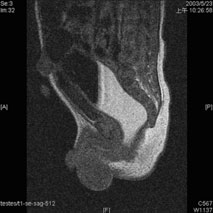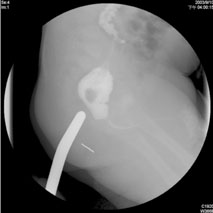|
Rectal atresia with rectourethral fistula: a rare anomaly
Chien-Hsing Lee, Ming-Chih Chou, Hui-Min Yeh
Changhua, Taiwan, China
Author Affiliations: Division of Pediatric Surgery, Department of Surgery, Changhua Christian Hospital, Changhua, Taiwan, China (Lee CH, Yeh HM); Institute of Medicine, Chung Shan Medical University, Taichung, Taiwan, China (Lee CH, Chou MC)
Corresponding Author: Chien-Hsing Lee, MD, Division of Pediatric Surgery, Department of Surgery, Changhua Christian Hospital, 135 Nanhsiao Street, Changhua 500, Taiwan, China (Tel: 886-4-723-8595; Fax: 886-4-763-4695; Email: 27566@cch.org.tw)
Background: Rectal atresia is an extremely rare anorectal malformation. We described a case of combined rectal atresia and rectourethral fistula.
Methods: The case was treated by a transverse loop colostomy after magnetic resonance imaging for confirming rectal atresia. He had anal dilation with a Hegar dilator at home and was readmitted to the hospital at age of 5 months for surgery. Distal colostography revealed a rectourethral fistula, and the gap between the two rectal pouches was 0.5 cm. The infant underwent a posterior sagittal repair.
Results: The infant was treated successfully after the fistula was excised and the continuity of the rectum was established by circumferential anatomosis. He is 2 years old now and passes stool daily.
Conclusion: Rectal atresia with rectourethral fistula can be treated successfully by a posterior sagittal approach.
Key words: rectal atresia; rectourethral fistula
World J Pediatr 2007;3(2):150-151
Introduction
Rectal atresia, an extremely rare anorectal malformation, is predominant in males with an incidence of 1%-2% in all anorectal anomalies. Only a few cases of rectal atresia with urinary fistula have been reported.[1,2] We present probably the first case of a male infant with a rectourethral fistula.
Case report
A full-term newborn male infant with abdominal distension and inability to pass meconium was referred to our hospital immediately after birth. Perineal examination revealed a normal anus; but a thermometer could only be introduced into the anus for 2 cm, suggesting rectal atresia. Magnetic resonance images revealed rectal atresia (Fig.1). After a transverse loop colostomy was performed, the infant was discharged from the hospital. He underwent anal dilatation with a Hegar dilator at home and was readmitted to the hospital at the age of 5 months for surgery. Distal colostography performed preoperatively revealed a rectourethral fistula, and the gap between the two rectal pouches was 0.5 cm (Fig. 2). The infant underwent a posterior sagittal repair. All the layers including the superficial and deep layers of the striated muscle complex and levator ani were divided at the midline to explore the rectal pouch. Subsequently, the fistula was excised and the continuity of the rectum was established by circumferential anastomosis. Anal dilatation was carried out on the second postoperative week and the colostomic site was closed after 2 months. The patient is 2 years old now, passes stool daily, and all follow-up examinations showed nothing abnormal.
 
Fig. 1. MRI showing the dilated colon with a blind end. Fig. 2. Distal colotogram showing a rectourethral fistular and a 0.5 cm gap between two rectal pouches.
Discussion
Rectal atresia is an extremely rare anomaly and constitutes 1%-2% of anorectal malformations with a male-female ratio of 7:3.[3] Only one case of rectal atresia with urinary fistula has been reported. Another case of rectal atresia with rectovestibular fistula was reported by Kulshrestha in 1997.[2]
The exact pathogenesis of rectal atresia is unknown, but it is postulated to be an acquired anomaly arising from intravascular thrombosis secondary to intrauterine infection.[3,4] Kisra et al[5] postulated that rectal atresia results from a vascular accident occurring between the 65 and 112 mm stages (13- to 14-week embryo) and that genetic factors play a minor role in the etiology.
The diagnosis is not difficult to confirm. A firm red rubber catheter of size 8 or 10, when passing per rectum, characteristically stops at 2-3 cm from the anal verge. A rectal examination further confirms the diagnosis.
Researchers have used perineal ultrasonography and magnetic resonance imaging to verify preoperatively the exact relation between the anal canal and sphincters.[3,6] Optimal continence is the ultimate goal in the treatment of all forms of anorectal anomalies. In most cases of rectal atresia, the anal canal and sphincter are normally formed, and therefore continence should be normal after reconstruction of atresia.
Operative methods include transanal end-to-end rectorectal anastomosis, mucosal proctectomy and colo-anal anastomosis, and posterior sagittal approach.[4,6,7] Because the anal canal and lower rectum constituting the lower pouch develope normally as the surrounding sphincteric musculature and the pelvic floor musculature, the prognosis is good.
Funding: There was no funding.
Ethical approval: Ethical approval was not needed.
Competing interest: None declared.
Contributors: LCH wrote the main body of the article under the supervision of CMC. LCH is the guarantor.
References
1 Prem P. Newborn surgery, 1st ed. Cabbridge: Butterworth Heinemann Pub, 1996: 395-398.
2 Kulshrestha S, Gangopadhyay AN, Sahoo SP. An unusual variant of rectal atresia with rectovestibular fistula. J Pediatr Surg 1997;32:921-922.
3 Saxena AK, Morcate JJ, Schleef J, Reich A, Willital GH. Rectal atresia, choanal atresia and congenital heart disease: a rare association. TecHealth Care 2004;12:343-345.
4 Sharma AK, Chaturvedi V, Wakhlu A. Anal agenesis associated with rectal atresia. J Pediatr Surg 1995;30:113-114.
5 Kisra M, Alkadi H, Ettayebi F, Benhammou M. Rectal atresia. J Pediatr Child Health 2005;41:691-693.
6 Vaneerdeweg W, Hubens G, Deprettere A. Mucosal proctectomy and colo-anal anastomosis as treatment of rectal atresia. J Pediatr Surg 1995;30:1722-1723.
7 Upadhyaya P. Rectal atresia: transanal, end-to-end, rectorectal anastomosis: a simplified, rational approach to management. J Pediatr Surg 1990;25:535-537.
Received July 16, 2006; Accepted after revision October 9, 2006
|

